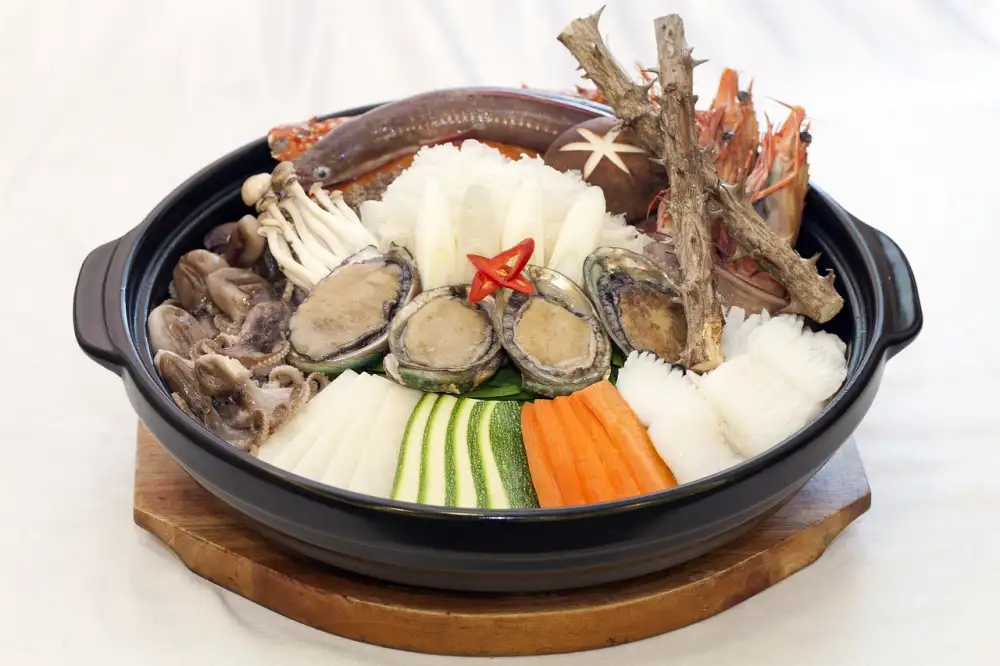Hotpot: Unveiling the Sizzling Delights of this Authentic Chinese Culinary Experience

Hotpot, also known as Chinese fondue, is a beloved culinary tradition that has been enjoyed for centuries. It is a communal dining experience where friends and family gather around a simmering pot of flavorful broth, cooking an array of fresh ingredients at the table. The sizzling sound and enticing aroma create an atmosphere of anticipation and excitement. Hotpot not only satisfies the taste buds but also fosters social connections as people bond over the shared experience of cooking and eating together. Join us as we delve into the world of hotpot and uncover its sizzling delights.
History and Origins of Hotpot
Hotpot, also known as Chinese fondue, has a rich history dating back over a thousand years. Its origins can be traced to the Jin Dynasty in China, where it was initially enjoyed by the ruling class. Over time, hotpot spread across different regions of China and became a popular culinary tradition.
The concept of hotpot is believed to have been influenced by Mongolian and Tibetan cooking styles. The nomadic tribes would cook meat and vegetables in a communal pot filled with boiling water or broth. This method allowed them to share resources and enjoy a warm meal during cold winters.
Hotpot gained popularity during the Tang Dynasty when it became a favorite among soldiers. It provided them with nourishment and warmth during long journeys and battles. As trade routes expanded, hotpot made its way to other parts of Asia, including Japan, Korea, and Southeast Asian countries.
In ancient times, hotpot was prepared using simple ingredients like meat, vegetables, and spices. However, as the dish evolved over centuries, various regional variations emerged. Today, hotpot is enjoyed with an array of ingredients such as thinly sliced meats (beef, lamb, pork), seafood (shrimp, fish balls), tofu, mushrooms, leafy greens, noodles, and more.
The history of hotpot reflects its significance as not just a delicious meal but also as a cultural tradition that brings people together. It continues to be cherished for its communal nature and the joy it brings to family gatherings and social events.
Ingredients Used in Hotpot
When it comes to hotpot, the key ingredients are what make this culinary experience truly unique and flavorful. Hotpot typically consists of a variety of fresh meats, seafood, vegetables, and noodles. The meat options can include thinly sliced beef, lamb, pork, or chicken. Seafood lovers can enjoy prawns, fish balls, squid, and scallops. Vegetables such as mushrooms, cabbage, lettuce, spinach, and bean sprouts add freshness and texture to the hotpot. Noodles like udon or glass noodles are also commonly added to the mix. These ingredients are carefully selected to ensure a balance of flavors and textures in every bite. Whether you prefer a meat-heavy hotpot or a vegetable-centric one, there is something for everyone to enjoy in this communal dining experience.
Types of Hotpot Broths
Hotpot is known for its flavorful and aromatic broths that form the foundation of this delectable dish. There are various types of hotpot broths, each with its own unique taste and characteristics.
1. Spicy Broth: This is the most popular and widely enjoyed hotpot broth. It is made by simmering a combination of spices, such as Sichuan peppercorns, dried chili peppers, garlic, and ginger. The result is a fiery and numbing broth that adds a kick to your hotpot experience.
2. Clear Broth: For those who prefer a milder flavor, the clear broth is an excellent choice. It is made by simmering bones or meat with vegetables and aromatics like onions, carrots, and celery. The clear broth allows the natural flavors of the ingredients to shine through.
3. Mushroom Broth: Vegetarians and mushroom lovers will delight in this flavorful broth. Made by simmering various types of mushrooms like shiitake, oyster mushrooms, and enoki mushrooms, it offers a rich umami taste that enhances the overall hotpot experience.
4. Tomato Broth: This tangy and refreshing broth is made by cooking tomatoes with herbs like basil and thyme. It adds a vibrant color to the hotpot while infusing it with a delightful sweetness.
5. Seafood Broth: If you're a seafood enthusiast, this broth is perfect for you. Made by boiling seafood shells along with vegetables like leeks and onions, it creates a rich and briny base that pairs well with seafood ingredients like fish balls, shrimp, or squid.
These are just some examples of the wide variety of hotpot broths available. Many restaurants offer customizable options where you can mix different broths or even create your own unique blend. The choice of broth ultimately depends on your personal preference for spiciness or richness in flavor. So, whether you prefer a fiery kick or a mild and comforting broth, hotpot has something to satisfy every palate.
Cooking Process of Hotpot
The cooking process of hotpot is a unique and interactive experience that brings people together. It starts with a pot of simmering broth placed in the center of the table, which acts as the foundation for the meal. The broth can be flavored with various ingredients such as herbs, spices, and aromatics to enhance its taste.
Once the broth is ready, an assortment of thinly sliced meats, seafood, vegetables, and tofu are prepared and placed on separate plates. Each diner then selects their desired ingredients and cooks them in the hotpot at their own pace. This allows for customization and ensures that everyone gets to enjoy their preferred level of doneness.
To cook the ingredients, simply dip them into the bubbling broth using chopsticks or a small strainer. The gentle simmering heat cooks the food quickly while retaining its natural flavors and textures. As each piece is cooked to perfection, it can be enjoyed with a variety of dipping sauces that add an extra layer of flavor.
The cooking process continues throughout the meal as more ingredients are added to the pot. This gradual addition creates layers of flavors in the broth, making it even more delicious as time goes on. It also encourages conversation and interaction among diners as they share cooking tips and recommendations.
Hotpot is not just about cooking food; it is also about enjoying a leisurely dining experience with family and friends. The slow-paced nature of hotpot allows for conversations to flow freely while savoring each bite. It fosters a sense of togetherness and creates lasting memories.
In conclusion, the cooking process of hotpot is simple yet engaging. It involves selecting fresh ingredients, cooking them in a flavorful broth, and enjoying them with loved ones. This interactive style of dining makes hotpot not only a delicious meal but also a social event that brings people closer together.
Popular Hotpot Variations
Hotpot is a versatile dish that can be customized to suit different tastes and preferences. There are numerous variations of hotpot, each with its own unique flavors and ingredients. One popular variation is the spicy Sichuan hotpot, known for its fiery broth made with Sichuan peppercorns and chili peppers. This hotpot is not for the faint-hearted, as it packs a punch of heat and numbing sensation.
Another popular variation is the seafood hotpot, which features an array of fresh seafood such as shrimp, fish, clams, and squid. The broth for this hotpot is usually light and flavorful, allowing the natural sweetness of the seafood to shine through.
For those who prefer a milder option, there is the herbal hotpot. This variation uses a broth infused with Chinese herbs such as goji berries, ginseng, and wolfberries. The herbs not only add depth of flavor but also provide health benefits.
Vegetarian hotpots have also gained popularity in recent years. These hotpots feature an assortment of fresh vegetables, tofu, mushrooms, and vegetarian protein substitutes like seitan or tempeh. The broth for vegetarian hotpots can be either vegetable-based or mushroom-based for added umami flavor.
In addition to these variations, there are regional adaptations of hotpot across China. For example, in Guangdong province, there is the famous Cantonese-style hotpot known for its rich and flavorful broths made from ingredients like chicken or pork bones.
No matter which variation you choose, hotpot offers a delightful dining experience where everyone can gather around the table to cook and enjoy their favorite ingredients together. It's a communal meal that brings people closer while savoring the delicious flavors of this beloved Chinese tradition.
Health Benefits of Hotpot
Hotpot not only offers a delightful culinary experience but also provides several health benefits. Firstly, hotpot is a low-fat cooking method as the ingredients are boiled instead of fried, reducing the intake of unhealthy fats. Secondly, hotpot is rich in nutrients as it includes a variety of fresh vegetables, meats, and seafood. This ensures a balanced meal with essential vitamins and minerals. Additionally, the slow cooking process retains the nutritional value of the ingredients. Moreover, hotpot promotes portion control as diners can choose their own ingredients and cook them individually. This helps in managing calorie intake and preventing overeating. Lastly, hotpot is known to improve digestion due to the warm broth and spices used in the cooking process. Overall, hotpot offers a healthy and nourishing dining option for those looking to enjoy a flavorful meal while prioritizing their well-being.
Tips for Enjoying Hotpot
1. Choose the Right Ingredients: Select a variety of fresh meats, seafood, vegetables, and noodles to enhance the flavors of your hotpot. Opt for thinly sliced meats and bite-sized vegetables for easy cooking.
2. Customize Your Broth: Experiment with different broths such as spicy Sichuan, mild chicken, or herbal mushroom to suit your taste preferences. You can even mix two broths for a unique flavor combination.
3. Control the Heat: Adjust the heat of your hotpot by adding or removing ingredients from the pot. If it gets too spicy or salty, add more vegetables or tofu to balance out the flavors.
4. Dip with Care: Use chopsticks or a small strainer to dip your cooked ingredients into sauces like sesame oil, soy sauce, garlic paste, or chili oil. Be mindful not to over-dip and overpower the natural flavors.
5. Cook in Batches: To ensure even cooking and prevent overcrowding in the pot, cook small portions at a time. This will help maintain the temperature and retain the freshness of each ingredient.
6. Pace Yourself: Hotpot is meant to be enjoyed slowly over a long period of time. Take breaks between bites and savor each mouthful to fully appreciate the flavors and textures.
7. Try New Flavors: Don't be afraid to experiment with new ingredients or spices in your hotpot. Add some exotic mushrooms, tofu skin rolls, or homemade meatballs to elevate your dining experience.
8. Stay Hydrated: Hotpot can be quite spicy and salty, so make sure to drink plenty of water throughout your meal to stay hydrated and cleanse your palate between bites.
9. Save Room for Dessert: After indulging in a hearty hotpot feast, end your meal on a sweet note with traditional Chinese desserts like red bean soup or mango pudding.
10. Share and Connect: Hotpot is a communal dining experience meant to be shared with family and friends. Engage in lively conversations, bond over cooking, and enjoy the warmth of togetherness that hotpot brings.
Hotpot Etiquette and Traditions
When it comes to enjoying hotpot, there are a few etiquette rules and traditions to keep in mind. Firstly, it is customary for the host or the eldest person at the table to take charge of cooking the ingredients. This person is responsible for ensuring that everyone's food is cooked properly.
Another important tradition is to use separate utensils for raw and cooked food. This helps prevent cross-contamination and ensures hygiene. It is also considered polite to offer food to others before serving yourself.
In terms of eating, it is common to use chopsticks or small strainers to pick up the cooked ingredients from the broth. Be careful not to splash hot broth on yourself or others while doing so.
Hotpot meals are meant to be enjoyed slowly, allowing conversation and interaction with friends and family. It is considered impolite to rush through the meal or leave early. Take your time, savor each bite, and enjoy the company of those around you.
Lastly, at the end of the meal, it is customary to drink a bowl of soup made from the remaining broth. This is believed to aid digestion and complete the hotpot experience.
By following these etiquette rules and embracing the traditions associated with hotpot, you can fully immerse yourself in this authentic Chinese culinary experience.
Hotpot is not just a meal, it is an experience that brings people together. The interactive nature of hotpot encourages conversation, laughter, and bonding among friends and family. Sharing the same pot and cooking ingredients together fosters a sense of togetherness and creates lasting memories.
Moreover, hotpot offers a wide range of flavors and textures that cater to everyone's preferences. From spicy broths to mild ones, there is something for every palate. The variety of ingredients allows for endless combinations and experimentation, making each hotpot session unique.
In addition to its social aspect, hotpot also boasts numerous health benefits. The use of fresh ingredients such as vegetables, seafood, and lean meats ensures a nutritious meal packed with vitamins and minerals. The cooking process preserves the natural flavors without the need for excessive oil or seasoning.
To fully enjoy the hotpot experience, it is important to follow some tips. Choose high-quality ingredients, experiment with different broths, and take your time to savor each bite. Remember to respect hotpot etiquette by not overcooking or wasting food.
Hotpot has deep-rooted traditions in Chinese culture but has gained popularity worldwide due to its deliciousness and communal nature. So gather your loved ones around a steaming pot of flavorful broth and embark on a culinary journey that will leave you craving more.
Published: 24. 11. 2023
Category: Food



